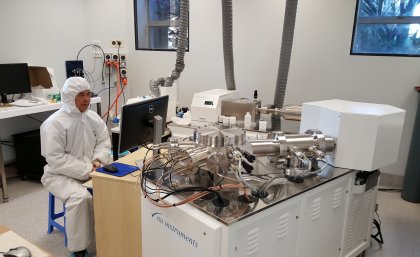.jpg?itok=P9hRGZ5d)
One of the most advanced analytical research laboratories of its kind will be opened to the public on Thursday, 13 July at The University of Queensland’s St Lucia campus.
New equipment worth $2.5 million will be showcased at the Centre for Geoanalytical Mass Spectrometry (CGMS), a hub backed by researchers from Queensland’s major research institutions.
Deputy Head of UQ’s School of Earth and Environmental Sciences and CGMS Director Professor Sue Golding said the centre was at the heart of an “exciting future-focused collaboration”.
“Some of the most sophisticated equipment in Australia has been assembled for use by research institutions, government and industry partners, and community clients,” Professor Golding said.
“Research projects are being tackled by UQ researchers and partner institutions using UQ-based facilities across diverse areas such as earth, environmental, biological, archaeological, forensic and material sciences.
“Projects include tracking ancient human origins and migration, mapping coral mortality in the Great Barrier Reef, and tracing metals in metabolic pathways and linking to chronic medical conditions.”
The UQ-funded facilities have received support from QIMR Berghofer Medical Research Institute and Griffith University, and seen the development of the Brisbane Geochronology Alliance between UQ, Griffith University and QUT - with the facilities as the centrepiece.
UQ’s Professor Jian-xin Zhao said the alliance sought to leverage each research institution’s strengths to make Brisbane a global hub for isotope geochemistry and geochronology.
“It’s important for technological development and expanding research across traditional boundaries, and will also result in a new generation of rising research stars, which augurs well for future research outcomes in Queensland and Australia,” Professor Zhao said.
The new equipment further enhances the initial and subsequent investments made by UQ, under the leadership of Emeritus Professor Ken Collerson, Professor Paulo Vasconcelos and Professor Jonathan Aitchison.
The equipment is important to maintain and further promote UQ and Queensland’s established international standing and reputation in isotope tracing and dating for multi-disciplinary research.
Director of Griffith University’s Australian Research Centre for Human Evolution Professor Rainer Grün said it was important to note Brisbane’s universities were collaborating rather than duplicating.
“Griffith University shared the purchase of the state-of-the-art laser ablation source. This allows the dating of valuable human fossils causing minimal damage,” Professor Grün said.
“The UQ facilities are complemented through the Brisbane Geochronology Alliance by the Optically Stimulated Luminescence and Electron Spin Resonance dating laboratories located at the Nathan Campus of Griffith University.”
Media: Professor Sue Golding, s.golding1@uq.edu.au, +61 7 3365 1159.
.jpg)


